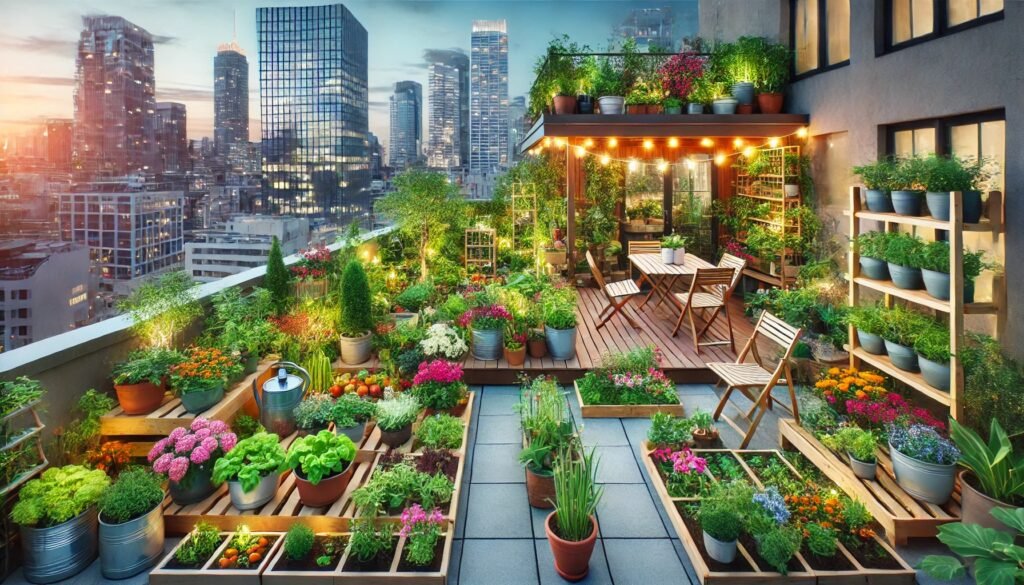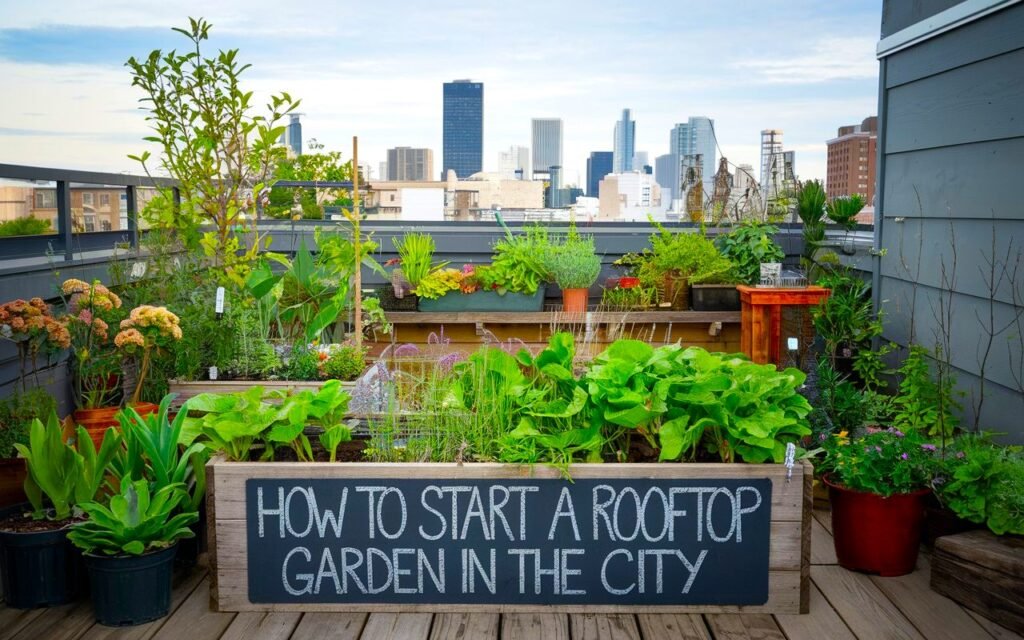Living in a city often means limited access to green space. But a balcony garden can be the perfect solution to being close to nature at home. It’s not just satisfying to start a garden on your city balcony. But it is also a sustainable way to grow fresh fruits and vegetables. Improve the quality of the garden and escape the hustle and bustle of the city in peace Here is a detailed guide based on personal experience to help you get started. This article will guide you through the basics of starting a hedge garden. From understanding structural requirements to choosing the right plants and maximizing your space. So let’s talk about how to start a rooftop garden in the city.
Learn How we Start a Rooftop Garden in the City
1. Assess Your Rooftop
The first step is to evaluate your rooftop’s structure and strength. Check with a professional to ensure that your rooftop can handle the additional weight of soil, plants, pots, and water. Additionally, verify if your building’s regulations or local zoning laws permit rooftop gardens. It’s crucial to have these checks done early to avoid any setbacks later.
Consider the direction your rooftop faces. South-facing rooftops typically receive the most sunlight, making them ideal for most plants. If your rooftop has shaded areas, plan to grow shade-tolerant plants in those spots. Don’t forget to measure the available space so you can maximize its potential without overcrowding.
2. Plan Your Layout
Before you start planting Create an outline of your garden project. A well-thought-out layout guarantees efficient use of space and resources. Consider:
- Sunlight Exposure: Observe the amount of sunlight your fabric receives each day. Most vegetables and flowers thrive when they receive 6 to 8 hours of sunlight. Use that information to decide which plants will go where.
- Wind Protection: Used bread sells a lot in the city, so consider adding a barrier, such as a trellis. dead tree cover Or a tall tree with a red face They hardly protect your garden. But it also adds beauty value.
- Water Access: Make sure you have a convenient water source nearby. You may want to invest in a drip system for efficient irrigation. If you have limited access to water Consider installing a water retention strip to supplement your water supply.
Include walking or trampoline routes on your map to facilitate organization. A clear and organized design will save you time and effort in the long run.

3. Choose the Right Containers for Start a Rooftop Garden
Opt for lightweight pots and containers to avoid overburdening or draping. Elevated cafeteria recycled wooden box And grow bags are a great option. Plastic poles are a popular choice because they are lightweight and durable. If beauty is important Terracotta or ceramic pots can also add charm. Embora sejam is heavier.
Ensure that all containers have adequate drainage holes to prevent overcrowding. Use a tray or film to cover the panels to retain excess water and prevent sticking. Containers with automatic watering are another good option. Especially for busy gardeners who may not water every day.
4. Select Suitable Plants
For beginners Start with plants that require little maintenance, such as:
- Herbs: Bread, vegetables, salsa, and basil are great for growing and are especially useful in cooking.
- Vegetables: Tomatoes, alfalfa, peppers, radishes, and spinach grow well in container gardens.
- Flowers: Malmegueres, petunias and amores-perfectos. Add bright colors and attract pollinators.
Consider your local climate and season when selecting plants. Native or drought-resistant species are often ideal for rooftop gardens as they require less maintenance and are more likely to thrive in local conditions. Don’t forget about vertical gardening for climbing plants like beans or cucumbers—it’s a great way to save space.
5. Prepare Quality Soil
Use lightweight, nutrient-dense packaging mixes instead of ordinary garden mixes. They can be heavy and compact. A good mix should include things like turf, perlite, and vermiculite. This ensures adequate aeration and drainage. Enrich or simply use organic compost to increase fertility and retain moisture.
If you are growing vegetables Consider adding a slow-release fertilizer to promote healthy growth. Check your pH level regularly to make sure it is within the ideal da faixa for your plants. Usually, it is between 6.0 and

6. Install Proper Drainage
Good drainage is critical to avoid water pooling on your rooftop. Place a layer of gravel or small stones at the bottom of your containers to improve water flow. Ensure that the water runoff system on your rooftop is clear and functional to prevent water from accumulating and damaging the structure.
If you’re using raised beds, line the bottom with a breathable fabric to allow water to drain while keeping soil in place. Regularly inspect your drainage system, especially during heavy rains, to ensure it’s working effectively.
7. Maintain Your Garden
Maintaining the health of your balcony garden requires regular maintenance. See how it works each day with maintenance:
- Watering: Follow a regular watering schedule. Especially during periods or moments that are extremely hot. The beginning of the month is the best time to water. This will reduce evaporation and give the plant time to absorb moisture before showering.
- Fertilizing: Feed the plant with organic fertilizer from time to time. Some weeks Sosinho’s nutrition must be reported.
- Pruning: Prune away dead leaves and stems regularly to encourage healthy growth and prevent disease.
- Pest Control: Track Prague and Doenças Use natural remedies like neem oil or add something wholesome like joninja to keep Prague residents busy. Avoid using harsh chemical pesticides that can harm the environment.
8. Add Personal Touches
Make your shaded garden a relaxing retreat by adding movies, fairy lights or decorative elements. A small seating area with comfortable chairs and a table can turn your garden into a local blanket to relax in after a long day. Try installing outdoor wallpaper, lamps, or even a small water source. to add charm
You can also customize your garden with themed sections, such as the herb cafeteria or the bubble garden. Adding treads or trellises can create a lush green landscape that enhances the overall atmosphere.
9. Benefits of a Rooftop Garden
From my experience Having a garden in the city has been transformative. It is a pleasure to gather fresh herbs for cooking. Watch the flowers undress and escape to a lush haven without leaving home. In addition to personal satisfaction Our fabric gardens also help reduce the impact of urban heat.Improve the quality and habitat of pollinators such as bees and butterflies.
Additionally, a balcony with a garden can significantly reduce costs in the backyard. Growing your own vegetables and herbs means fewer trips to the market and access to fresh and organic produce within reach.
10. Overcoming Challenges
Gardening with urban fabric comes with its own set of challenges: limited space, and adverse weather conditions. And access can be a barrier. I say that with careful planning and creative solutions. These challenges can be overcome. For example:
- Use vertical gardening techniques to increase space.
- To shield plants from extreme heat, install awnings or shade.
- Invest in a portable container to easily move the plant if necessary.

Final Thoughts
An engaging activity that fosters a connection to nature is cultivating an urban garden. Even in a desert city careful preparation routine maintenance And a little imagination are enough. You can project a thriving, attractive, and useful green space. Indoor gardening isn’t just a hobby. Rather, it is a lifestyle change that promotes sustainability and well-being.
Then turn on your garden lights and start today to transform unused fabric into a living garden! Whether you plant tomatoes for succulents or flowers for spirituality, The effort you put into your garden in your hedge will be rewarded many times over.
FAQ: Rooftop Gardening in the City
1. Can I start a rooftop garden in a rented property? Yes, but you need permission from your landlord and should ensure the rooftop can handle the weight of a garden.
2. Which plants are ideal for a rooftop garden? Herbs, tomatoes, lettuce, peppers, and flowers like marigolds and petunias are great choices for beginners.
3. How do I protect my plants from strong winds? Use windbreaks like trellises, mesh screens, or tall plants to shield your garden from harsh winds.
4. Is rooftop gardening expensive? It depends on the setup. You can start small with recycled containers and gradually invest in tools and materials as needed.
5. How much sunlight does a rooftop garden need? A large number of plants need six to eight hours of sunlight every day. Observe your rooftop’s sun exposure to plan your layout effectively.



